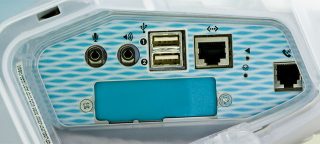August 1998: Three months ago it looked like a risky move: The iMac would use the universal serial bus (USB), but not ADB, SCSI, or a standard Mac serial port.
Although Microsoft and Intel have promoted USB, and the vast army of clone makers have been building USB into their computers, I don’t know of one computer that dropped the standard serial and parallel ports that every Wintel user expects.
This means that despite the widespread presence of USB on modern Wintel boxes, and OS support in Windows, there hasn’t been a whole lot of USB hardware.
- So what does Apple do? It forces the issue!
 With the same chutzpah seen in leaving out the floppy drive, Apple has gone where no computer has gone before – into the land of USB only.
With the same chutzpah seen in leaving out the floppy drive, Apple has gone where no computer has gone before – into the land of USB only.
Despite the efforts of Microsoft, Intel, and others to establish USB as a new standard, it was tiny, innovative, thinking different Apple that forced the peripheral industry to move into USB country.
After all, if Apple sells a half-million (or even a million) iMacs this year, that’s a lot of people who won’t be able to buy your printer, scanner, trackball, or external drive – unless you adopt USB.
Apple at first pushed USB as an industry standard, but the iMac will do more to create a USB market and allow USB to become the perceived standard than all the Wintel boxes with USB ports combined.
Even though the Windows world will be the primary beneficiary of USB in the long run, little old Apple is the one pushing the envelope.
Ironic, isn’t it, that a company with less than 10% market share carries this much weight.
Related Reading
- USB, Good Enough for the Low End, Online Tech Journal
- USB and the OfficeJet, the iMac channel
- Why USB Is a Good Thing, the iMac channel
keywords: #imac #usb

